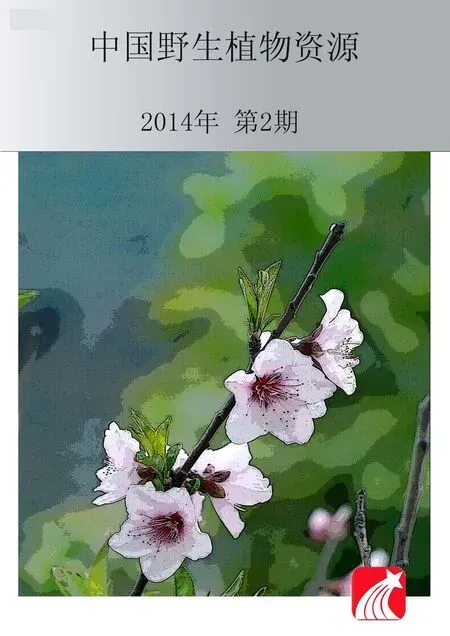藜科植物三萜皂苷类化学成分研究与利用
马 鑫,陈 雨,白 柏,冯 煦,梁敬钰
(1.中国药科大学 天然药物化学研究室,江苏 南京 211198; 2.江苏省中国科学院 植物研究开发中心,江苏 南京 210014;3.中国科学院南京分院 东台滩涂研究院,江苏 东台 224200)
藜科(Chenopodiaceae)植物全世界共约130个属1500余种, 广泛分布于欧亚大陆、南北美洲、非洲和大洋洲的半干旱及盐碱地区[1-3]。中国有藜科植物38属184种(不包括外来种属)[4],我国的藜科资源植物主要有菠菜属(Spinacia)、盐角草属(Salicornia)、猪毛菜属(Salsola)、碱蓬属(Suaeda)、藜属(Chenopodium)、地肤属(Kochia)、驼绒藜属(Ceratoides)、滨藜属(Atriplex)、梭梭属(Haloxylon)、假木贼属(Anabasis)等[5]。
从藜科植物中分离得到的化合物主要有生物碱、甾体、萜类、黄酮、三萜等。近年来随着分离技术和二维核磁共振谱技术的迅速发展,越来越多的三萜皂苷从该科植物中分离得到。相关研究表明,三萜皂苷在藜科药用植物中不仅含量高,而且具有多种生物活性,引起人们重视。
目前,从藜科植物中分离得到的三萜皂苷主要为齐墩果烷型,苷元分别有齐墩果酸、常春藤皂苷元、美商陆酸、Serjanic acid、降三萜等。
本文对从藜科植物中分离鉴定的三萜皂苷的结构类型、植物分布、生物活性等方面进行综述与展望。
1 化学成分研究
藜科植物三萜皂苷及三萜皂苷元化合物见表1~12。

表1 藜科植物中的齐墩果酸型三萜皂苷(元)成分

续表1

表2 藜科植物中的常春藤皂苷元型三萜皂苷(元)成分

续表2

表3 藜科植物中的美商陆酸型三萜皂苷(元)成分

表4 藜科植物中的Serjanic acid型三萜皂苷(元)成分

表5 藜科植物中的棉根皂苷元型三萜皂苷(元)成分

表6 藜科植物中的3β,29α-dihydroxy-olean-12-en-28-oic acid型三萜皂苷成分

表7 藜科植物中的3β,22α-dihydroxy-olean-12-en-28-oic acid型三萜皂苷成分

表8 藜科植物中的longispinogenin型三萜皂苷(元)成分

表9 藜科植物中的saikogenin F型三萜皂苷(元)成分

表10 藜科植物中的模绕酸型三萜皂苷(元)成分

表11 藜科植物中的30-降齐墩果酸型三萜皂苷(元)成分

表12 藜科植物中的其他类型三萜皂苷(元)成分
2 藜科植物三萜皂苷的药理活性
2.1 抗炎、抗过敏作用
地肤子水提物可降低小鼠单核巨噬系统的吞噬功能,醇提物可抑制炎症和Ⅰ、Ⅱ、Ⅲ型变态反应。地肤子所含皂苷为止痒抗炎及抑制Ⅰ型变态反应的有效成分,而主要抗炎活性成分为地肤子皂苷Ⅱ及其苷元齐墩果酸。抗炎作用的机理与地肤子甲醇提取物显著抑制脂多糖(LPS)诱导的肿瘤坏死因子α(TNF-α)前列腺素E2(PGE2)一氧化氮(NO)等炎性递质的释放有关[27]。
从藜麦种子中分得的3-O-β-D-glucopyranosyl oleanolic acid具有较强的抗炎活性[28]。
从Anabasis setifera中分得的3-O-α-L-rhamnopyranosyl-(1→4)-β-D——galactopyranosyl-(1→6)-β-D-glucopyranosyl sophradiol可抑制环氧化酶(COX-1和COX-2)[26]。
2.2 降糖作用
戴岳等[29]对地肤子总皂苷降糖作用的研究显示,地肤子总皂苷灌胃给药,对正常小鼠血糖无明显影响,高剂量使血糖略有升高,但能降低四氧嘧啶所致高血糖小鼠的血糖水平;地肤子总皂苷明显抑制灌胃葡萄糖引起的小鼠血糖升高,而对腹腔注射葡萄糖所致小鼠血糖上升无显著影响,并呈剂量依赖性抑制正常小鼠胃排空对地肤子正丁醇提取物降糖作用的研究显示[30],正丁醇提取物灌胃能显著抑制小鼠胃排空和降低四氧嘧啶所致高血糖小鼠的血糖水平,正丁醇提取物能浓度依赖性地减少大鼠小肠对葡萄糖的吸收其降糖机制可能与抑制糖在胃肠道的转运或吸收有关。
2.3 抗微生物作用
Woldemichael[31]等对藜麦的研究表明,藜麦粗皂苷混合物在50 μg/mL可抑制白色念球菌生长,而单体皂苷活性很低或活性,表明可能皂苷之间存在协同作用。3-O-β-D-glucopyranosyl l-(1→3)-α-L-arabinopyranosyl hederagenin 28-O-β-D-glucopyranosyl ester,3-O-β-D-glucopyranosyl-(1→3)-α-L-arabinopyranosyl phytolaccagenic acid 28-O-β-D-glucopyranosyl ester抗菌活性。]皂苷的抗真菌活性通常比其苷元的活性低,同时苷元的抗真菌活性与苷元骨架上的官能团有直接关系[7]。
2.4 溶血作用
Woldemichael[31]等研究藜麦发现单糖链皂苷的溶血活性高于双糖链皂苷的,双糖链皂苷如在28位连4个糖,3位连一个糖也具有一定的溶血作用。Voutquenne等认溶血活性与糖链上糖的个数以及3位是否含有糖链或者苷元骨架上是否含有官能团如羧基或16位羟基等有关,28位自由羧基的存在对皂苷的细胞毒活性有直接的影响。
2.5 抑制胃排空活性
Momordin Ic[32]可显著抑制胃排空,12.5~50 mg/kg对1.5%羧甲基纤维素钠负荷小鼠胃排空抑制率可达8.4%~60.6%,50 mg/kg对40%葡萄糖负荷小鼠胃排空抑制率可达42%,对牛奶负荷小鼠胃排空抑制率可达36.4%,对60%乙醇负荷小鼠胃排空抑制率可达37.2%。
2.6 灭螺活性
藜麦种皮[33]用碱处理将双糖苷转化成单糖苷,灭螺活性显著增加,33 mg/mL 24 h,可100%杀死Pomacea canaliculata snails,而双糖苷几乎无活性。藜麦中的单糖苷在较高浓度54 mg/mL时对金鱼和罗非鱼没有毒性,而市售的灭螺剂杀Pomacea canaliculata snails同时也会杀死鱼。Ricardo San Mart1′n等还发现灭螺活性可能与碱处理后形成更多的憎水化合物与Pomacea canaliculata snails中的胆固醇有更好的亲和力有关。
3 结 语
我国藜科植物分布广泛,产量高,资源丰富。目前,从藜科中分离得到的三萜皂苷类成分正在逐渐增多,某些三萜皂苷还具有较好的生物活性,如抗炎、抗过敏、降糖、抗微生物等活性。但研究报道大部分是对其总提取物进行药理活性研究,各类药理活性的物质基础并不明确,活性成分的作用机制也不清楚。因此需要进一步研究其化学成分与各类药理活性的关系,阐明其活性物质基础及活性物质的作用机制,为其临床用药和药材的质量控制提供依据。另外,藜科生物活性成分的产业化技术研究与应用较少,应加快提取分离技术工厂化的步伐,利用植物细胞和组织培养等生物技术,对植物资源进行快速繁殖和集约化栽培,满足工厂化对原材料的需求。同时以活性物质为先导化合物,进行结构优化,合成一系列结构相似、活性高的化合物,为新药的研究与开发提供依据。
参考文献:
[1] Tutin T G. Chenopodiaceae[M]∥Flora europaea Cambrige, The University Press,1964,1:90-108.
[2] Wilson P G. Chenopodiaceae[M]∥Flora of Australia Canberra Australian Govenment Publishing Service,1984,4:81-330.
[3] Wu Z Y. Discussion on plant flora regionalization in China[J]. Acta Bot Yunnanica,1979,1:1-20
[4] Zhu G L. Origin, differentiation and geographic distribution of the Chenopodiaceae[J]. Acta Phytotaxonomica Sin,1995,34:486-504.
[5] Kong X W, Zhu G L, Jian Z P, et al. Chenopodiaceous plants in China[J]. Acta Phytotaxonomica Sin,1978,16:99-123.
[6] Whang W K ,Hahn D R. Saponins from the fructus of Kochia scoparia[J]. Archives of pharmacal research,1991,14(2):176-180.
[7] Whang W K ,Hahn D R. Saponins from the fructus of Kochia scoparia[J]. Archives of pharmacal research,1991,14(2):176-180.
[8] 文晔,陈英杰,李嘉和.地肤子中皂苷的研究[J].中药材,1993,16(6):28-30.
[9] Yoshikawa M, Murakami T, Kadoya M,et al. Medicinal foodstuffs.3.Sugar beet (1):Hypoglycemic oleanolic acid oligoglycosides, betavulgarosides I, II, III, and IV, from the root of Beta vulgaris L. (Chenopodiaceae)[J]. Chemical and pharmaceutical bulletin,1996,44(6):1212-1217.
[10] Rastrelli L, De Simone F, Schettino O,et al. Constituents of Chenopodium pallidicaule (Canihua) seeds: isolation and characterization of new triterpene saponins[J]. Journal of agricultural and food chemistry,1996,44(11):3528-3533.
[11] Wang Q Z, Liu X F, Shan Y,et al. Two new nortriterpenoid saponins from Salicornia bigelovii Torr. and their cytotoxic activity[J]. Fitoterapia,2012,83(4):742-749.
[12] Yin M, Wang X Y, Wang M, et al. A new titerpenoid saponin and other saponins from Salicornia europaea[J].Chemistry of Natural Compounds,2012,48(2):258-261.
[13] Hamed A I, Masullo M, Sheded M G,et al. Triterpene saponins from Salsola imbricata[J]. Phytochemistry Letters,2011,4(3):353-356.
[14] Gohar A A, Maatooq G T, Niwa M,et al. A new triterpene saponin from Chenopodium ficifolium[J]. Zeitschrift fur Naturforschung C-Journal of Biosciences,2002,57(7-8):597-602.
[15] Yoshikawa M, Murakami T, Kadoya M,et al. Medicinal foodstuffs. XV. Sugar beet.(2): Structures of betavulgarosides Ⅴ, Ⅵ, Ⅶ, Ⅷ, Ⅸ, and Ⅹ from the roots and leaves of sugar beet (Beta vulgaris L, Chenopodiaceae)[J]. Chemical and pharmaceutical bulletin,1998,46(11):1758-1762.
[16] Yoshikawa M, Shimada H, Morikawa T,et al. Medicinal foodstuffs .7. On the saponin constituents with glucose and alcohol absorption-inhibitory activity from a food garnish “Tonburi”, the fruit of Japanese Kochia scoparia (L) SCHRAD: Structures of scoparianosides A, B, and C[J]. Chemical and pharmaceutical bulletin,1997,45(8):1300-1305.
[17] Wen Y, Chen Y, Cui Z,et al. Triterpenoid glycosides from the fruits of Kochia scoparia[J]. Planta Medica,1995,61(05):450-452.
[18] Lavaud C, Voutquenne L, Bal P,et al. Saponins from Chenopodium album[J]. Fitoterapia,2000,71(3):338-340.
[19] 汪豪,范春林,王蓓.中药地肤子的三萜和皂苷成分研究[J].中国天然药物,2003,1(3):134-136.
[20] Massiot G, Dijoux M, Lavaud C,et al. Seco-glycosides of oleanolic acid from Beta vulgaris[J]. Phytochemistry,1994,37(6):1667.
[21] Yeskaliyeva B, Ahmed M M, Abbaskhan A,et al. Bioactive flavonoids and saponins from Climacoptera obtusifolia[J]. Phytochemistry,2006,67(21):2392-2397.
[22] Kim Y A, Kong C S, Lee J I,et al. Evaluation of novel antioxidant triterpenoid saponins from the halophyte Salicornia herbacea[J]. Bioorganic & Medicinal Chemistry Letters,2012,22(13):4318-4322.
[23] Mithöfer A, Jakupovic J, Weiler E. A triterpenoid glycoside from Spinacia oleracea[J]. Natural Product Letters,1999,14(1):5-10.
[24] Shaker K H, Dockendorff K, and Seifert K. Triterpenoid saponins from Atriplex semibaccata[J]. Zeitschrift Fur Naturforschung C,2003,58(7/8):485-489.
[25] Yoshikawa M, Dai Y, Shimada H,et al. Studies on Kochiae Fructus. II. On the saponin constituents from the fruit of Chinese Kochia scoparia (Chenopodiaceae): chemical structures of kochianosides I, II, III, and IV[J]. Chemical and pharmaceutical bulletin,1997,45(6):1052-1055.
[26] Abdou A M, Abdallah H M, Mohamed M A,et al. A new anti-inflammatory triterpene saponin isolated from Anabasis setifera[J]. Archives of pharmacal research,2013:1-8.
[27] 蒋剑平,沈小青,范海珠.地肤子化学成分及药理活性研究进展[J].中华中医药学刊,2011,29(12):2704-2706.
[28] Ma W W, Heinstein P, McLaughlin J,et al. Additional toxic, bitter saponins from the seeds of Chenopodium quinoa[J]. Journal of natural products,1989,52(5):1132-1135.
[29] 戴岳,刘学英.地肤子总苷降糖作用的研究[J].中国野生植物资源,2002,21(5):36.
[30] 戴岳,夏玉凤,林己茏.地肤子正丁醇部分降糖机制的研究[J].中药药理与临床,2003,19(5):21-24.
[31] Woldemichael G M, Wink M. Identification and biological activities of triterpenoid saponins from Chenopodium quinoa[J]. Journal of agricultural and food chemistry,2001,49(5):2327-2332.
[32] Matsuda H. Inhibition of gastric emptying by triterpene saponin, momordin Ic, in mice: Roles of blood glucose, capsaicin-sensitive sensory nerves, and central nervous system[J]. Journal of Pharmacology and Experimental Therapeutics,1999,289(2):729-734
[33] Martin R S, Ndjoko K, Hostettmann K. Novel molluscicide against Pomacea canaliculata based on quinoa (Chenopodium quinoa) saponins[J]. Crop Protection,2008,27(3-5):310-319.

